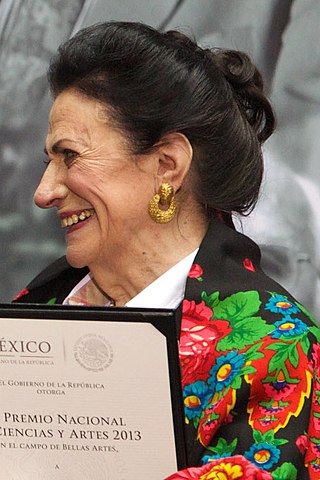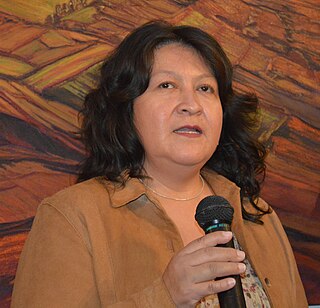Related Research Articles
Francisco Díaz de León was a Mexican graphic artist, notable for pioneering much of modern Mexican graphic arts. He spent his childhood around books and when he studied art in Mexico City, he specialized in engraving and illustration. He spent his career illustrating books, magazines and more, reviving techniques such as dry point and introducing new techniques and styles such as the use of color and linoleum printing. He was also a noted arts education, directing several schools including the Escuela Mexicana de las Artes del Libro, which he founded. He was a founding member of the Academia de Artes and a member of the Salón de la Plástica Mexicana. In 1969 he received the Premio Nacional de Artes for engraving.

Ángela Gurría Davó was a Mexican sculptor. In 1974, she became the first female member of the Academia de Artes. She is best known for her monumental sculptures such as Señal, an eighteen-meter tall work created for the 1968 Summer Olympics. She lived and worked in Mexico City.

Geles Cabrera Alvarado is a Mexico City sculptor who has worked in a variety of materials, there is a museum dedicated to her work in the south of the city.

José Julio Gaona Adame is a Mexican painter noted for his depictions of women and girls in strong lines and bright colors, usually doing ordinary activities. Member of the Salón de la Plástica Mexicana and other professional organizations in Mexico, he has had over 135 exhibitions of his work in both Mexico and abroad.

Antonio García Vega is a Mexican artist and member of the Salón de la Plástica Mexicana. He began exhibiting his work while still in school in the early 1970s and continues to do so, often working with his brother Mauricio García Vega. He works in mixed media to paint various forms of expression. His early work was mostly fantastic, with elements of eroticism but his later work has been darker as a means of expressing his own feelings and moods. His work has mostly been exhibited in Mexico, often in conjunction with other artists including a 2010 exhibition with his brother at various venues.

Deyanira África González Melo is a Mexican sculptor who generally works in ceramics, depicting elements of the human form, especially the torso, generally with mutilations and other disturbing elements to dispute the otherwise traditional and sensual depictions of the human body. She has exhibited her work since studying at the Escuela Nacional de Artes Plásticas (ENAP) in Mexico as well as in Europe and the Caribbean. Her work has received recognition in Mexico and abroad, and is a member of the Salón de la Plástica Mexicana.
Eliana Menassé is a Mexican painter and member of the Salón de la Plástica Mexicana, an honor society for Mexican artists.

Herlinda Sánchez Laurel was a Mexican artist and art professor at the Universidad Nacional Autónoma de México. Her career has been recognized by membership in the Salón de la Plástica Mexicana, and awards from the state of Baja California, the Palacio de Bellas Artes and the International Coordination of Women in Art among others.
Lourdes Alaniz is a Mexican painter and graphic artist whose work has been recognized with exhibition in Mexico’s Salón de la Plástica Mexicana.
Rocio Caballero is a Mexican figurative painter, whose works often depict mythical worlds and are noted for her use of symbolism. Her work has been exhibited individually and collectively in Mexico, the United States, South America and Europe and can be found in collections such as that of the National Museum of Mexican Art. Her work has been recognized with membership in the Salón de la Plástica Mexicana.
Susana Campos is a Mexican artist whose work tends to be complex compositions in various media generally introspective or commentary on society. She has had over thirty five individual exhibitions in Mexico and participated in various collective exhibitions in Mexico and abroad. Her work has been recognized with membership in the Salón de la Plástica Mexicana since 1966, and has been written about by various noted art writers in Mexico.

Angelica Carrasco is a Mexican graphic artist who is a pioneer of large scale printmaking in the country. Her work often is related to violence and classified as “abstract neo-expressionism.” Much of her career has been dedicated to teaching and the promotion of the arts, especially the graphic arts and has been recognized with membership in the Salón de la Plástica Mexicana and the Sistema Nacional de Creadores de Arte.

María Eugenia Chellet is a Mexican artist who has evolved from photography to mixed media and currently focuses mostly on performance. Her work focuses on exploring female archetypes and other images relating to femininity, often using herself in roles such as female Biblical figures, those in classical artwork and those from commercial mass media of the 20th century to the present. Her work has been recognized with membership in the Salón de la Plástica Mexicana.

Christa Cowrie is a German-Mexican photographer, who began her career in photojournalism but is best known for her work documenting Mexico’s dance the theater events. Cowrie arrived in Mexico in 1963 and began her career in 1975 with the Excélsior newspaper. In 1977, she was one of the founders of the Unomásuno newspaper, also working to found one its supplements, focusing on ecological journalism. Her work began to shift towards photography dance and theater in the mid 1990s working with the Centro Nacional de las Artes. The archive she has created with this institution is one of the most important in Mexico documenting dance and theater. Her work has been recognized with membership in the Salón de la Plástica Mexicana.
Myriam de la Riva is a Mexican artist known for her small scale works as well as portable murals. She was born in Mexico City to a European family in exile. She studied art in both Mexico and the United States as well as with a number of notable Mexican artists. The artist has had over fifty individual exhibitions and her work has been shown in over 500 collective shows. Her work has been recognized with membership in the Salón de la Plástica Mexicana, among other awards.
Consuelo González Salazar is a Mexican painter whose work has been recognized with membership in the country’s Salón de la Plástica Mexicana.
Tania Janco is a Czech and Mexican artist, known for her painting and print work, especially in the illustration of children's books. Her work has been recognized the Caravelle D’ora Prize in Italy and membership in the Salón de la Plástica Mexicana.
Flor Minor is a Mexican sculptor and graphic artist, known for bronze sculptures and graphic work that generally depict the male form. Her works often are based on the concept of balance or lack thereof. Minor has had individual exhibitions in notable venues in Mexico and abroad, and her work can be found in a number of public and private collections. She has been recognized in Mexico with membership in the Salón de la Plástica Mexicana.
Yolanda Quijano is a Mexican painter and sculptor whose work has been recognized with membership in the Salón de la Plástica Mexicana.
Noemí Ramírez is a Mexican visual artist, whose work has been recognized with several honors including membership in the Salón de la Plástica Mexicana.